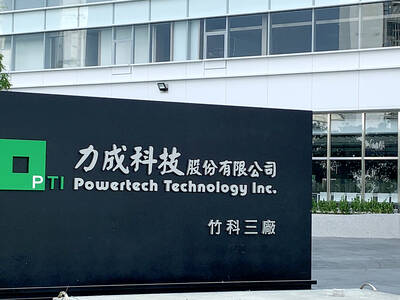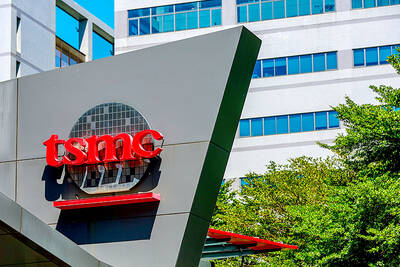The average selling price of DRAM chips next quarter is expected to decline by up to 8 percent quarter-on-quarter, with memory chips used in notebook computers and consumer electronics seeing the steepest decline due to excess inventory and a shortage of components, market researcher TrendForce Corp (集邦科技) said yesterday.
That means the DRAM industry is entering a new downcycle after experiencing a boom for three quarters, the longest uptrend in the history of the industry.
The Taipei-based researcher said it expects the balance between supply and demand to begin tilting toward a surplus in the final quarter of this year.
Most DRAM buyers are cautious about placing new orders, as their inventories have risen above safe levels, TrendForce said.
The average selling price of DRAM chips would slide between 3 and 8 percent next quarter from this quarter, the first decline since the first quarter of this year, it said.
The price of DRAM chips for laptops would fall between 5 and 10 percent, as a decline in demand for laptops would cause a PC DRAM chip surplus of 1.38 percent, TrendForce said.
Buying sentiment for Chromebooks is running out of steam, as students and workers are gradually returning to schools and offices after the US and European economies reopened, it said.
As PC makers have speculated that DRAM prices could weaken further, PC DRAM chip prices might decline more than 10 percent for some transactions next quarter, TrendForce said.
However, a slump in the PC DRAM segment would not likely trigger a large-scale downturn, as PC DRAM chips only account for a relatively small portion of major DRAM manufacturers’ total DRAM capacity, and chipmakers might allocate more capacity to server DRAM production amid steady server demand, it said.
The price of DRAM chips used in servers would remain the same or drop up to 5 percent next quarter, as growth momentum is slowing from the third quarter because US and Chinese cloud-server providers have ensured they have high inventory levels for eight to 10 weeks, the researcher said.
The price of DRAM chips used in consumer electronics would fall between 5 and 10 percent, as spending on home entertainment electronics is declining due to relaxed COVID-19 restrictions, it said.
Besides, a severe component shortage has led to lower shipments of TVs, set-top boxes and networking devices, as well as industrial devices, dragging down demand for DRAM chips, TrendForce said.
The price of DRAM chips used in mobile devices would be largely flat, but there is the likelihood of a decline due to high inventory levels ahead of the slack season in the first quarter, TrendForce said.
Demand for DRAM chips used in graphics cards looks resilient amid a recovery in cryptocurrency mining activities and robust demand for commercial laptop computers, TrendForce said, adding that the price of graphics card DRAM chips would be flat or drop 5 percent next quarter, it said.
Uneven supply of key components, including driver ICs, power management ICs and graphics cards is weakening buying sentiment, the researcher added.

The DBS Foundation yesterday announced the launch of two flagship programs, “Silver Motion” and “Happier Caregiver, Healthier Seniors,” in partnership with CCILU Ltd, Hondao Senior Citizens’ Welfare Foundation and the Garden of Hope Foundation to help Taiwan face the challenges of a rapidly aging population. The foundation said it would invest S$4.91 million (US$3.8 million) over three years to foster inclusion and resilience in an aging society. “Aging may bring challenges, but it also brings opportunities. With many Asian markets rapidly becoming super-aged, the DBS Foundation is working with a regional ecosystem of like-minded partners across the private, public and people sectors

BREAKTHROUGH TECH: Powertech expects its fan-out PLP system to become mainstream, saying it can offer three-times greater production throughput Chip packaging service provider Powertech Technology Inc (力成科技) plans to more than double its capital expenditures next year to more than NT$40 billion (US$1.31 billion) as demand for its new panel-level packaging (PLP) technology, primarily used in chips for artificial intelligence (AI) applications, has greatly exceeded what it can supply. A significant portion of the budget, about US$1 billion, would be earmarked for fan-out PLP technology, Powertech told investors yesterday. Its heavy investment in fan-out PLP technology over the past 10 years is expected to bear fruit in 2027 after the technology enters volume production, it said, adding that the tech would

Taiwan Semiconductor Manufacturing Co (TSMC, 台積電) has secured three construction permits for its plan to build a state-of-the-art A14 wafer fab in Taichung, and is likely to start construction soon, the Central Taiwan Science Park Bureau said yesterday. Speaking with CNA, Wang Chun-chieh (王俊傑), deputy director general of the science park bureau, said the world’s largest contract chipmaker has received three construction permits — one to build a fab to roll out sophisticated chips, another to build a central utility plant to provide water and electricity for the facility and the other to build three office buildings. With the three permits, TSMC

YEAR-END BOOST: The holiday shopping season in the US and Europe, combined with rising demand for AI applications, is expected to drive exports to a new high, the NDC said Taiwan’s business climate monitor improved last month, transitioning from steady growth for the first time in five months, as robust global demand for artificial intelligence (AI) products and new iPhone shipments boosted exports and corporate sales, the National Development Council (NDC) said yesterday. The council uses a five-color system to measure the nation’s economic state, with “green” indicating steady growth, “red” suggesting a boom and “blue” reflecting a recession. “Yellow-red” and “yellow-blue” suggest a transition to a stronger or weaker condition. The total score of the monitor’s composite index rose to 35 points from a revised 31 in August, ending a four-month